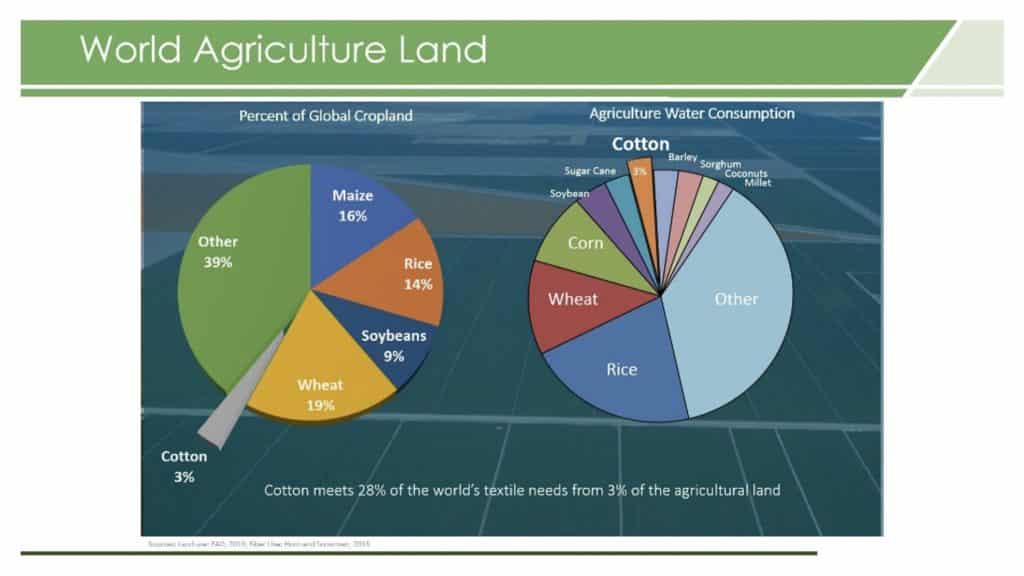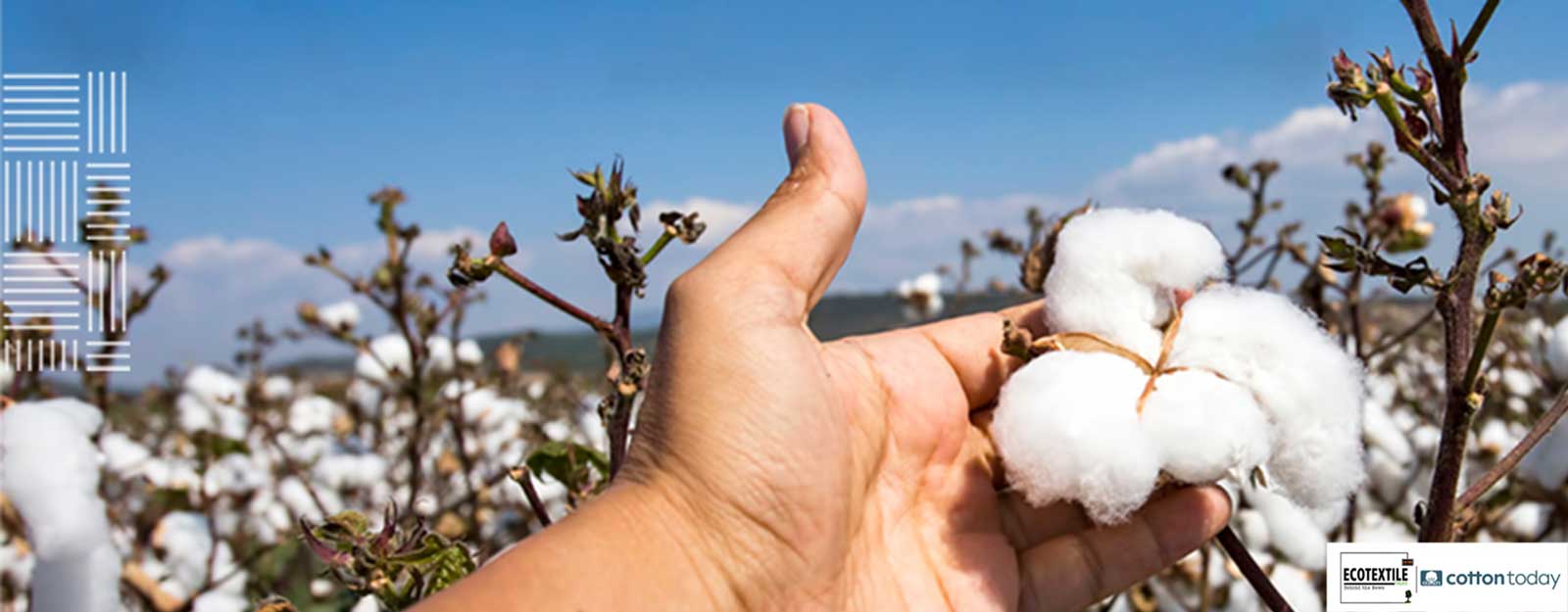Water remains one of the most important resources due it its impact on our everyday lives, especially as we work with our changing environment. The impact of climate change, however, has made it challenging for growers to manage this resource. Currently, nearly half of the United States (44.6 percent) is impacted by “moderate to exceptional” drought, according to the National Oceanic and Atmospheric Administration (NOAA). New research warns of the risk of “megafloods” that could result from climate change[1], more recent flooding across the United States could be a precursor to more extreme weather events.
Water has always been an important part of the sustainability conversation for the cotton industry as the industry has made significant progress in managing an increasingly scarce resource. Beyond just reexamining some of the more traditional ways cotton is managing its water use, we wanted to take a deeper dive into some of the innovative advancements Cotton Incorporated and its partners are making around water usage.
Drought Tolerant
Cotton is naturally drought tolerant and can grow in a variety of climate conditions, making it a viable crop in arid regions, despite a common misconception that cotton is a water-intensive crop. Cotton is planted on roughly 3 percent of the global agriculture land and uses roughly the same share (3 percent) of agriculture water.[2] Unlike many other crops, cotton’s water needs are fairly flexible as it can still grow and produce even when all the water the plant could use is not available. This is partially due to cotton’s tap root, which can grow as deep as 6 feet to make use of soil water. Additionally, cotton’s flexibility allows it to flower throughout its life cycle, meaning that it can take a break during a dry period and then start flowering again next time it rains.
In the U.S., 64% of the cotton produced relies solely on rainfall, while only 5% is fully irrigated. However, like all plants, cotton needs water to flourish. With such a heavy reliance on rainfall, as well as an increasing number of extreme weather events, it is essential that we look at opportunities to make better use of rainfall storage and provide better protection for crops.
Cotton’s Water Strategy
The cotton industry has a comprehensive water strategy, starting with defining the amount of water needed and tracking key metrics around usage. The industry primarily looks at the amount of cotton fiber and seed produced per volume of water – called water productivity. Compared to 20 years ago, we produce much more cotton per acre, with virtually no increase (or even a small decrease) in water usage. For irrigated cotton, we also measure cotton productivity against the volume of irrigation water applied.
Today, growers use state-of-the-art technology to map their fields and track exactly where water is needed, ensuring they are not overusing this precious resource. Many growers today use modern technology to help manage their precision irrigation efforts. Growers have a smartphone app for irrigation scheduling – the farmer just picks their field location on a map and the planting date. The app then pulls in weather data from a nearby weather station or a national weather grid to predict the next time irrigation is needed.
Another portion of cotton’s water strategy is to better utilize farm ponds and shallow ground water recharge. At its core, a farm pond is simply a water source created by a farmer that is designed to capture and store rain water for future use. This simple concept, however, can have a significant impact on water usage and crop productivity.
Water Capture Research
Dr. Mohamed Youssef at North Carolina State University, with support by Cotton Incorporated, is leading a study of the sustainability benefits of farm ponds throughout the southeastern U.S. Farm ponds can potentially increase cotton’s resilience to long dry periods while also protecting water quality by reducing the loss of nutrients and sediment due to rain runoff.[3] The project is designed to better combat the uncertain nature of rainfall in the region.
Currently, growers are contending with long dry periods interspersed with high intensity rainfall events. The water lost during heavy rainfalls could be stored as an irrigation source during dry periods, while simultaneously increasing fertilizer use efficiency by reducing the loss of nutrients. Ideally, this study will provide growers with more accurate guidance around design and management of these farm ponds.
Separately, Dr. Michele Reba, a research hydrologist and lead scientist at the USDA-ARS Delta Water Management Research Unit (DWMRU) at Arkansas State University, has been exploring the feasibility of using on-farm ponds as source water for managed aquifer recharge in the mid-south. Managed aquifer recharge is the purposeful recharge of aquifers for later use. Mid-south growers confront some of the same water issues as those in the southeast: sufficient rainfall but a frequency and intensity that doesn’t align with cotton’s growing schedule. By better storing and utilizing rainwater, growers rely less on local water sources and aquifers, better protecting those water resources.[4]
One final tangential benefit of increasing groundwater storage capacity is the potential environmental benefits of mitigating floods. When more extreme rainfall events occur, natural water storage can overflow and cause dangerous flooding. Increased water storage in agriculture has the potential to reduce the risk of flooding.[5]
Water is an essential human resource that is becoming increasingly more scarce. Meanwhile, global climate change is leading to more extreme weather events, including longer droughts and more high-volume rainfall events. These extremes present growers with challenges of utilizing rainfall while also protecting crops from runoff. By building on the natural drought-resistant characteristics of cotton through tactics like smart measurement, precision irrigation and better methods for storing and recycling rainwater, we will continue to ensure that we’re protecting this vital resource.

Ed Barnes, Ph.D.
Senior Director of Agricultural & Environmental Research
[1] Huang, X and Swain, D. Climate Change is increasing the risk of a California megaflood. Science Advances, 2022. (doi:10.1126/sciadv.abq0995).
[2] FAO, 2013; Horn and Snowman, 2013.
[3] Christopher H. Hay, Benjamin D. Reinhart, Jane R. Frankenberger, Matthew J. Helmers, Xinhua Jia, Kelly A. Nelson, Mohamed A. Youssef. 2021. Frontier: Drainage Water Recycling in the Humid Regions of the U.S.: Challenges and Opportunities. Transactions of the ASABE. 64(3): 1095-1102. (doi: 10.13031/trans.14207)
[4] Reba, M.L., Massey, J.H., Adviento-Borbe, M.A., Leslie, D., Yaegar, M.A., Anders, M., Farris, J. Aquifer Depletion in the Lower Mississippi River Basin: Challenges and Solutions. Universities Council on Water Resources, Issue 162, Pages 128-139, December 2017. https://onlinelibrary.wiley.com/doi/pdfdirect/10.1111/j.1936-704X.2017.03264.x
[5] Baker, J.M., Griffis, T.J., Ochsner, T.E. 2012. Coupling landscape water storage and supplemental irrigation to increase productivity and improve environmental stewardship in the U.S. Midwest. Water Resources Research 48: W05301, doi:10.1029/2011WR011780, 2012




